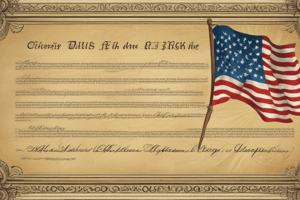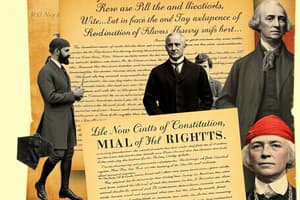Podcast
Questions and Answers
The ______ position argued that the Constitution made the federal government too powerful and did not provide enough protections for individual rights.
The ______ position argued that the Constitution made the federal government too powerful and did not provide enough protections for individual rights.
Anti-Federalist
The compromise to add a ______ of rights to the Constitution was necessary to gain the political support of the Anti-Federalists.
The compromise to add a ______ of rights to the Constitution was necessary to gain the political support of the Anti-Federalists.
bill
Delaware was the first state to ______ the new Constitution on December 7, 1787.
Delaware was the first state to ______ the new Constitution on December 7, 1787.
ratify
The debate over ratification was ______ in Massachusetts.
The debate over ratification was ______ in Massachusetts.
The small states were satisfied with the compromise guaranteeing them equal representation in the ______.
The small states were satisfied with the compromise guaranteeing them equal representation in the ______.
The conflict over ratifying the new Constitution led to a necessary ______ in order for the document to be adopted.
The conflict over ratifying the new Constitution led to a necessary ______ in order for the document to be adopted.
The Constitutional Convention of ______ was held to address the concerns of the delegates.
The Constitutional Convention of ______ was held to address the concerns of the delegates.
The Connecticut Plan proposed a legislature with two houses, including the House of ______ and the Senate.
The Connecticut Plan proposed a legislature with two houses, including the House of ______ and the Senate.
According to the compromise, a slave would be counted as ______ of a person in determining congressional representation.
According to the compromise, a slave would be counted as ______ of a person in determining congressional representation.
The ______ party, led by Alexander Hamilton, James Madison, and John Jay, supported a strong central government.
The ______ party, led by Alexander Hamilton, James Madison, and John Jay, supported a strong central government.
The ______ party opposed a strong central government and instead favored strong state governments.
The ______ party opposed a strong central government and instead favored strong state governments.
Article ______ of the Constitution outlines the ratification process by which states could approve the Constitution.
Article ______ of the Constitution outlines the ratification process by which states could approve the Constitution.
The ______ Convention sent the new U.S. Constitution to the states for ratification.
The ______ Convention sent the new U.S. Constitution to the states for ratification.
According to Article VII of the Constitution, ______ of the 13 states needed to ratify the document in order for it to go into effect.
According to Article VII of the Constitution, ______ of the 13 states needed to ratify the document in order for it to go into effect.
Some states decided to vote through their state ______ to consider ratification.
Some states decided to vote through their state ______ to consider ratification.
The ______ supported the Constitution, while the Anti-Federalists opposed it.
The ______ supported the Constitution, while the Anti-Federalists opposed it.
The ratification process involved a significant amount of ______ and debate.
The ratification process involved a significant amount of ______ and debate.
The states were to hold ______ conventions and vote on whether or not they would accept the new Constitution.
The states were to hold ______ conventions and vote on whether or not they would accept the new Constitution.




